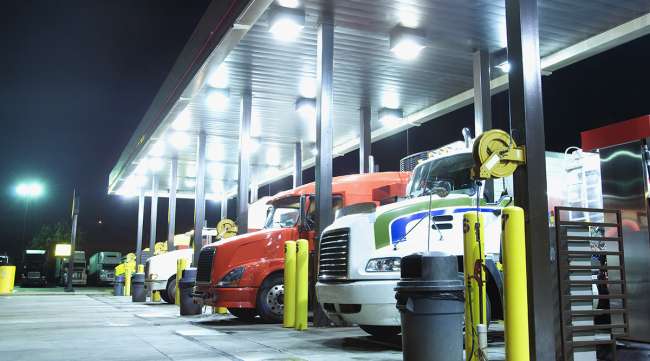Senior Reporter
Diesel Slips 0.2¢ to $2.596 a Gallon

The U.S. average retail price of diesel dipped 0.2 cent to $2.596 as crude oil prices were flat amid forecasts U.S. shale oil production will set a record in September, experts said.
Diesel costs 22.6 cents more than it did a year ago, when it was $2.370 a gallon, the Department of Energy said Aug. 21.
Prices for trucking’s main fuel dropped in all regions except in the Rocky Mountain, West Coast and California districts.
It was diesel’s first decline after seven consecutive weeks of price increases.
The U.S. average price for regular gasoline fell 2.4 cents to $2.360 a gallon. The cost is 16.7 cents more than it was a year ago, DOE’s Energy Information Administration said.
Weekly gasoline prices rose in three regions along the West Coast and fell in six, EIA said.
US #Diesel price Down 0.2¢ to $2.596/gal, up 22.6¢ over last year. Data: https://t.co/NS3eJxOiAd #Radio spot: https://t.co/GmRf5zkneW — EIA (@EIAgov) August 22, 2017
Meanwhile, looming in the Gulf of Mexico was Tropical Storm Harvey, which was forecast as of press time to become a Category 1 hurricane by Aug. 25. It was on track for Texas, the National Weather Service Storm Prediction Center reported, home to offshore oil rigs and inland refineries.
If a disruption occurs, though, it will affect demand for fuel the most, one expert said.
“The one thing to remember is hurricanes tend to be more demand destroyers than they are supply destroyers,” Denton Cinquegrana, chief oil analyst for the Oil Price Information Service, told Transport Topics.
“When you are dealing with flooding, people can’t move. At the same time, refineries have more resources to get flooding abated and get their units back up and running quicker than some places might be able to get rid of the flooding in their towns,” he said.
Hurricane Harvey is on a path that will have it slamming into Texas's coast Friday https://t.co/rlGQNLNwb1 pic.twitter.com/frwFsJRXKO — Bloomberg (@business) August 24, 2017
The Gulf Coast from Corpus Christi, Texas, to Lake Charles, La., is home to nearly 30 refineries making up about 7 million barrels a day of refining capacity, or one-third of the U.S. total, according to Bloomberg News.
Meanwhile, one scientist forecast natural gas will increasingly become a fuel for heavy-duty trucks, citing economics, climate change and local air-quality factors discussed in a recent study.
“If diesel prices rise, there will be more adoption beyond the current pilot fleets,” Nigel Clark, campus provost for West Virginia University Institute of Technology, told TT. “Also, reduced methane loss across the supply chain will promote the use of natural gas as a low carbon fuel. This may be driven by mandates and rules.”
In addition, the lower emissions from natural gas trucks improves regional air quality, Clark said. “In California, there is the natural gas refuse truck rule. So this is a growth point for vocational trucks, including package delivery.”
Researchers at West Virginia University’s Center for Alternative Fuels, Engines and Emissions published the study Aug. 23. It modeled possible scenarios of methane emissions from a larger fleet in 2035. Methane is the main component of natural gas and a powerful greenhouse gas, according to the study.
In the meantime, distillate fuel product supplies — which is primarily ultra-low-sulfur diesel and a marker for domestic demand — fell to 4.2 million barrels a day for the week ending Aug. 18, compared with 4.3 million a week earlier, EIA said.
Also, distillate supplies were flat and remain in the upper half of the average range for this time of year, while distillate fuel production decreased, averaging 5.1 million barrels per day, EIA said.
West Texas Intermediate crude futures on the New York Mercantile Exchange closed at $47.37 per barrel Aug. 21 compared with $47.59 on Aug. 14.
U.S. crude oil inventories fell 3.3 million barrels to 463.2 million barrels but are still in the upper half of the average range for this time of year, EIA said.
U.S. crude stockpiles have slipped for seven straight weeks, Bloomberg News reported Aug. 20.
“The fact that U.S. inventories have come down so much is definitely a good sign, suggesting that the global market is coming back into balance, but we certainly don’t see the death of shale at $50,” Michael Lynch, president of Strategic Energy & Economic Research in Winchester, Mass., told Bloomberg. “That’s becoming increasingly clear.”
But output from major shale plays is set to climb to a record next month, according to Bloomberg.
Also, the number of drilled but uncompleted wells in shale regions in July — the latest available period — rose by 208, compared with a month earlier, to 7,059, EIA reported.
Uncompleted wells “are like inventory for a manufacturer … and represent hundreds of thousands of barrels a day of potential oil production,” according to a Bloomberg columnist.




